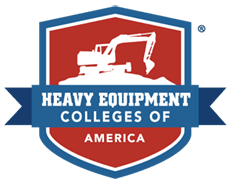When you’re operating a multi-ton hunk of metal carrying heavy cargo, there’s an inherent risk of something going wrong and causing an accident. Some of the most common types of accidents that happen with a crane include rigging failures, electrocution, and equipment failure.
With the proper steps and safety measures, these types of accidents are preventable. Heavy Equipment Colleges of America (HEC) has years of experience training up-and-coming crane operators, and we know the ins and outs of the equipment. We’ll go over 12 basic steps you can take to better protect yourself and others on the job site.
Table of Contents
Rigorous Training Programs
Building a strong foundation before you set foot on a job site can set you up for success. Proper training and education about the basics of crane operations and safety protocols can help you feel prepared when you step into the cabin.
At Heavy Equipment Colleges of America, we offer extensive training and certification programs for cranes and other heavy machinery. Knowing your way around the equipment and OSHA safety regulations will protect you on the job site and help prevent serious accidents.
Start Your Crane Career With Confidence
Train With Experts at Heavy Equipment Colleges of America
Hands-On Training | OSHA Safety Courses | Industry-Ready Skills
Become a Certified Crane Operator Today!
Start Enrollment ProcessFind The Right Location For You1. Continuous Skill Development
Learning isn’t limited to the classroom. Once you earn your certifications and go through proper training, you continue to learn and build your skills on the job site.
Don’t catch yourself getting stagnant; keep learning as you go and building your skillset. The more you learn and strengthen your skills, the better your work becomes. You can improve your efficiency, productivity, and safety as you get to work.
2. Daily and Annual Inspections
Sometimes, the workload gets heavy, and your schedule can get chaotic. Small things like visual equipment inspections can sometimes slip through the cracks. However, these quick daily inspections can save you the heartache and pain of a serious workplace accident. Looking over the equipment can catch minor issues before they become more serious, keeping yourself and others on the job site safe.
Don’t let annual inspections slip by. Schedule an in-depth crane inspection to ensure the equipment is ready to go and has no hidden issues.
3. Identifying Mechanical Issues Early
Small issues can quickly progress into something serious if unaddressed. With proper routine inspections, you can catch mechanical issues early before they escalate.
Mechanical issues can sneak up on you if you don’t pay attention. From gradual wear and tear over time to a faulty part, addressing the problem when it’s minor prevents an equipment breakdown and a catastrophic workplace accident.
4. Proper Load Handling Techniques
Cranes are designed to lift and transport heavy loads across a job site to where they need to be. These loads need to be properly secured to the crane and handled with care.
Crane operators need to remain aware of their surroundings and carefully move the load to prevent a collision or other accident. Properly handling the load can reduce the risk of a crane accident.
5. Effective Rigging Practices
Cranes can carry loads high overhead, and the load needs to be properly secured to keep everyone safe. Without proper rigging, materials from the load can fall off and lead to serious injuries.
Practice safe and effective rigging to make sure the load materials are snug in the crane. Don’t rush through this step; take your time and make sure you abide by rigging best practices.
Prevent Accidents with Professional Training
Enroll in HEC’s Crane Operation Programs
Hands-On Training | Real Equipment Experience | Expert Instructors
Build a Safer, More Successful Career!
Start Enrollment ProcessFind The Right Location For You6. Standardized Hand Signals and Radio Protocols
Exclusion zones around a crane keep nearby workers safe and prevent unauthorized individuals from getting too close to the equipment. Certain areas around a crane, such as their blind spots, are incredibly dangerous to stand in.
Set clear expectations of where these exclusion zones are and how to avoid them. If you have the resources, you can even set up barricades or fencing to block off these areas.
7. Establishing Exclusion Zones
Exclusion zones around a crane keep nearby workers safe and prevent unauthorized individuals from getting too close to the equipment. Certain areas around a crane, such as their blind spots, are incredibly dangerous to stand in.
Set clear expectations of where these exclusion zones are and how to avoid them. If you have the resources, you can even set up barricades or fencing to block off these areas.
8. Routine Maintenance Schedules
Routine maintenance is a vital task that you never want to push to the side. Set a clear maintenance schedule that abides by OSHA regulations and other safety standards.
Keeping up on minor repairs and maintenance keeps the equipment in tip-top shape, which in turn helps prevent accidents. When the crane is able to operate at its best, the risk of a breakdown or serious problem is greatly reduced.
9. Addressing Wear and Tear
Cranes do a lot of heavy lifting on a job site, and over time, this can lead to wear and tear. Gradual wear is inevitable as you use the equipment, but you can keep on top of it to prevent it from progressing further.
When you spot wear and tear on the equipment, such as worn pieces or aging metal, patch the damage quickly to keep it from getting worse. Repairing multiple minor issues is better than waiting until they become much more serious.
10. Integration of Modern Safety Devices
Safety equipment and technologies are constantly evolving and changing with the times. Keeping up to date with the latest technology can maximize job site safety and help prevent dangerous workplace accidents.
11. Preventing Overload and Tipping
Since cranes are carrying heavy loads high in the air, poor loading and weight management can make them top-heavy and run the risk of tipping over. Abiding by maximum load weights and proper weight distribution can keep the crane balanced and secure as it moves around.
12. Monitoring Hazardous Conditions
Outside factors such as the weather can have a serious impact on crane safety and productivity. Keep an eye on the weather forecast and plan your work accordingly. Whether it be postponing work due to heavy winds or setting up additional lighting when it gets dark out, preparing for nature can keep you and others on the site safe.
Get Started On the Path to a New Career With HEC
Proper crane safety training and certifications can get you on the road to a long and successful career as a crane operator. At Heavy Equipment Colleges of America, we offer extensive training programs that include general first aid, OSHA courses, and various crane certifications.
Whether you want to work with mobile cranes or tower cranes, we’ve got the program for you. Apply online or speak with one of our admissions representatives to start your career as a crane operator today!
Learn to Operate Safely & Efficiently
Get Certified Through HEC’s Crane Training
Safety-Focused Curriculum | Fast-Track Programs | Job Support Services
Secure Your Future in Heavy Equipment Today!
Start Enrollment ProcessFind The Right Location For You
